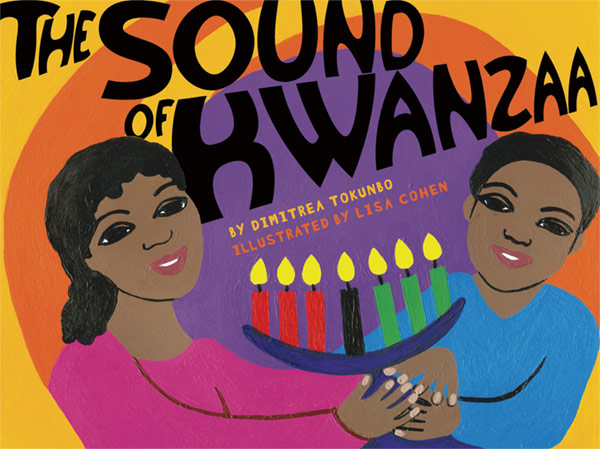For many weeks now, you’ve been listening to Christmas music. Maybe you’ve even sung some carols yourself.
You’ve seen Christmas ads on TV, and by now, you probably already watched a few Christmas cartoons and specials. If you haven’t already, you’ll soon be hearing “ho-ho-ho” and jingle bells, “Merry Christmas” and other sounds of the holidays.
But if you listen after Christmas, you’ll hear joyful noises for another special celebration. In the new book “The Sound of Kwanzaa” by Dimitrea Tokunbo, illustrated by Lisa Cohen, you’ll learn what those noises mean.
Every night of Kwanzaa, someone may ask you “Habari gani?” That means “What’s the news?” in Swahili. To answer, you say the word of the day. Just as there are seven days of Kwanzaa, there are seven words, each with different meaning. Together, they’re called the Nguzo Saba.
On the first night of Kwanzaa, you’ll hear the sounds of your friends and family. The first night celebrates Umoja, and you light a black candle for unity. Umoja is the word for “unity”
The second night is Kujichagulia, a night for learning the traditions of your parents and grandparents. You’ll also hear stories from your elders, maybe some lessons, and you’ll light a red candle. Kujichagulia means “self-determination.”
If you hear the sounds of someone at work on the third night, don’t be surprised. That means you’re celebrating Ujima. Ujima means “collective work and responsibility” so it’s a good time to do chores together. You light a green candle on this night.
On the fourth night, you’ll celebrate Ujamaa, which means “cooperative economics” or supporting local merchants. Yep, Ujamaa means shopping and it also means another red candle on this fourth night.
Do you have a special dream? Say it out loud and listen to others as they share their hopes and goals on Nia, the fifth night of Kwanzaa. Nia means “purpose” and it also means another green candle.
If you like to sing or play a musical instrument, you’ll like the sixth night of Kwanzaa. That’s the night of Kuumba, which means “creativity,” so sing out loud and light a red candle.
On the seventh night of Kwanzaa, you’ll light a green candle and celebrate Imani, which means “faith.” On this last night, prayers are said and a karamu is often held.
Happy Kwanzaa to everyone!
Over the years, I’ve wondered why Kwanzaa isn’t embraced by people of other cultures. After reading “The Sound of Kwanzaa,” I wonder even more. It’s such a beautiful tradition.
Tokunbo also relates a little history behind the celebration, a few personal notes, and an easy-to-follow no-bake brownie recipe that your kids will want to make for their own last-night karamu.
When you’re done with ho-ho-ho, get ready for “Harambee!” by grabbing this book.
(“The Sound of Kwanzaa” by Dimitrea Tokunbo 2009, Scholastic Press, $16.99, 32 pages.)
